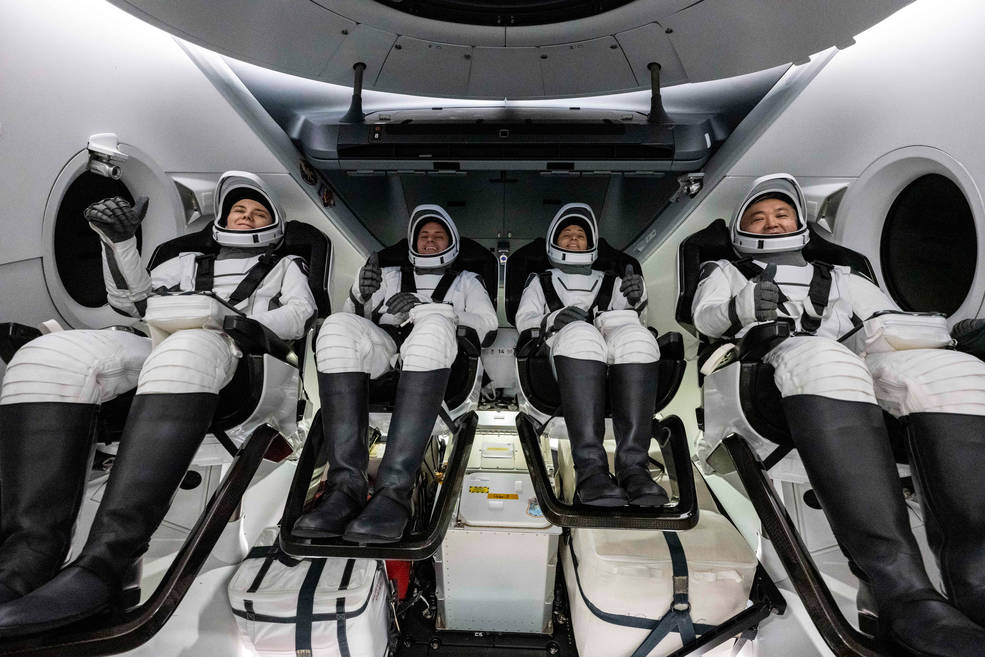
After splashing down safely in their Dragon spacecraft off the coast of Tampa, Florida, on Saturday, NASA’s SpaceX Crew-5 completed the agency’s fifth commercial crew rotation mission to the International Space Station. The international crew of four spent 157 days in orbit.
NASA astronauts Nicole Mann and Josh Cassada, along with JAXA (Japan Aerospace Exploration Agency) astronaut Koichi Wakata, and Roscosmos cosmonaut Anna Kikina, returned to Earth in a parachute-assisted splashdown at 9:02 p.m. EST. Teams aboard SpaceX recovery vessels retrieved the spacecraft and spacefarers. After returning to shore, the crew will fly to NASA’s Johnson Space Center in Houston.
“Welcome home, Crew-5! This international crew has been conducting critical science experiments and technology demonstrations on the International Space Station that will help prepare us for future deep space missions and pave the way for our return to the Moon,” said NASA Administrator Bill Nelson. “Each advancement these explorers make is not an achievement for one, but a giant leap for all of humanity.”
The Crew-5 mission lifted off at 12 p.m. EDT Oct. 5, 2022, on a Falcon 9 rocket from NASA’s Kennedy Space Center in Florida. About 17 hours later, Dragon docked to the Harmony module’s forward-facing port. The crew undocked from the same port at 2:20 a.m. Saturday, to begin the trip home.
Mann, Cassada, Wakata, and Kikina traveled 66,577,531 miles during their mission, spent 156.5 days aboard the space station, and completed 2512 orbits around Earth. The Crew-5 mission was the first spaceflight for Mann, Cassada, and Kikina. Wakata has logged 505 days in space over his five flights.
Throughout their mission, the Crew-5 team contributed to a host of science and maintenance activities and technology demonstrations. Cassada joined NASA astronaut Frank Rubio to conduct three spacewalks, preparing the station for and installing two new iROSAs, or International Space Station Roll-Out Solar Arrays. Mann and Wakata teamed up for two spacewalks, also outfitting the orbiting laboratory for solar array augmentation.
During their time on station, the crew members also tested hydroponic and aeroponic techniques to grow plants without using soil, released Uganda and Zimbabwe’s first satellites, studied how liquids move in a container in simulated lunar gravity to generate data to improve Moon rover designs, and tested an on-demand system to produce specific quantities of key nutrients from yogurt, kefir, and a yeast-based beverage. The astronauts grew dwarf tomatoes in efforts to address the need for a continuous fresh-food production capability in space and reinstalled the station’s bioprinting facility as a stepping stone in long-term plans to manufacture whole human organs in space.
This was the second flight of the Dragon spacecraft, named Endurance by the Crew-3 astronauts on its maiden voyage. Endurance will return to Florida for inspection and processing at SpaceX’s Dragon Lair, where teams will inspect the spacecraft, analyze data on its performance, and process it for its next flight.
The Crew-5 flight is part of NASA’s Commercial Crew Program and its return to Earth follows on the heels of NASA’s SpaceX Crew-6 launch, which docked to the station March 3, beginning another science expedition.
The goal of NASA’s Commercial Crew Program is safe, reliable, and cost-effective transportation to and from the International Space Station and low-Earth orbit. This already is providing additional research time and has increased the opportunity for discovery aboard humanity’s microgravity testbed for exploration, including helping NASA prepare for human exploration of the Moon and Mars.
Learn more about NASA’s Commercial Crew program at:
https://www.nasa.gov/commercialcrew
-end-
Joshua Finch / Lora Bleacher
Headquarters, Washington
202-358-1100
joshua.a.finch@nasa.gov / lora.v.bleacher@nasa.gov
Brittney Thorpe / Kathleen Haas Ellis
Kennedy Space Center, Fla.
321-867-2468
Brittney.thorpe@nasa.gov / kathleen.h.ellis@nasa.gov
Leah Cheshier / Sandra Jones
Johnson Space Center, Houston
281-483-5111
leah.d.cheshier@nasa.gov / sandra.p.jones@nasa.gov


























